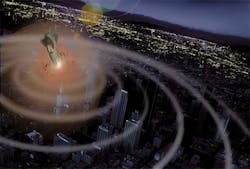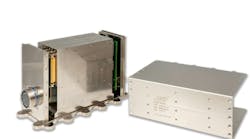Officials of the Directed Energy Directorate of the Air Force Research Laboratory at Kirtland Air Force Base, N.M., released a broad agency announcement Tuesday for new initiatives in the High Power Electromagnetics (HPEM) Cyber and Electronic Warfare Applications (CEWA) program.
The HPEM CEWA project seeks to use high-power electromagnetics technologies to support and enhance the missions of the military cyber and EW communities.
Air Force researchers particularly are interested in using single-shot HPEM technology, multi-shot HPEM technology, and specialized waveform technologies. Sponsoring the effort are officials of the Directed Energy Directorate's High Power Electromagnetic Division, Cyber/ Electronic Warfare Applications Program (AFRL/RDHA).
Research will include the study, analysis, and formulation of scenarios in which HPEM can be used for cyber or EW applications, as well as to conduct experiments and demonstrate innovative concepts, researchers say.
The program will be as long as five years and as much as $10 million in task orders. Air Force officials say they expect to award as many as three separate contracts for the program. U.S. military leaders recognize opportunities in combining cyber and electronic warfare technologies in what some call spectrum warfare.
Air Force researchers began the HPEM CEWA program 2013 to find new ways of using HPEM technologies to improve cyber warfare and electronic warfare capabilities. Previous efforts have centered on HPEM technologies for directed-energy weapons. The program thus far has produced creative ideas for using single-shot HPEM technology, multi-shot HPEM technology, and specialized waveform technologies.
Related: Backpack electronic warfare (EW) helps Marines counter roadside bombs, enemy communications
The newest objectives for the program involve effects caused by backdoor coupling phenomenology and concepts unique to exposing test assets to high-power densities, researchers say.
Researchers want to identify the radio frequency power density, pulse width, pulse repetition rate, and other parameters based on cyber and EW experiments. Experts want to understand how robust HPEM effects can be in cyber and EW applications based on experiments.
To prove new concepts, Air Force researchers want contractors chose to demonstrate technical HPEM concepts at field experiments such as Black Dart or Vigilant Hammer.
Related: DARPA picks six companies to define enabling technologies for U.S. cyber warfare strategy
Companies interested should send responses no later than 26 Feb. 2016 to the Air Force's Victoria Lloyd, AFRL Det 8/RVKDP, 3550 Aberdeen Ave. SE, Bldg. 499, Kirtland AFB, NM 87117-5776.
For technical questions or concerns phone Pete Finlay at 505-846-8386, or Tyrone Tran at 505- 846-0299. Phone contracting questions or concerns to Victoria Lloyd at 505-846-0392, or Pearl Solano at 505-853-6494.
More information is online at https://www.fbo.gov/spg/USAF/AFMC/AFRLPLDED/BAA-RVKD-2014-0003_CALL_0001/listing.html.



